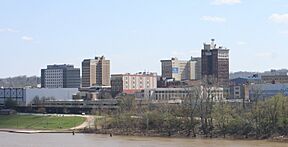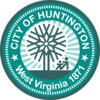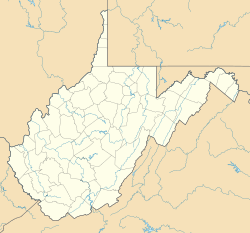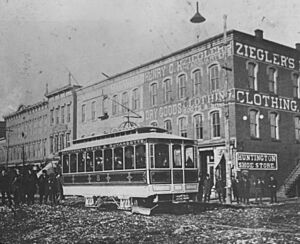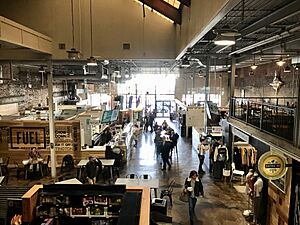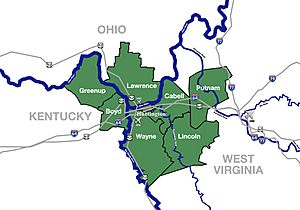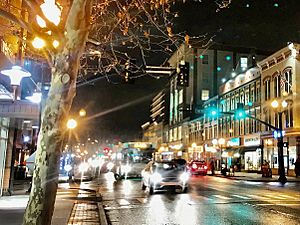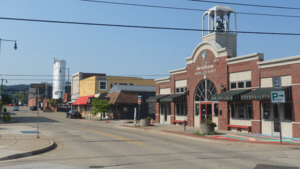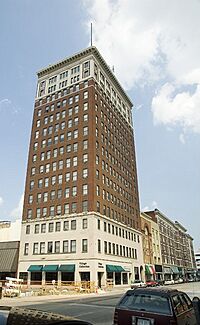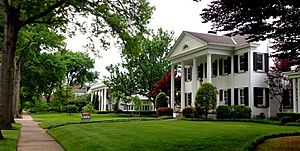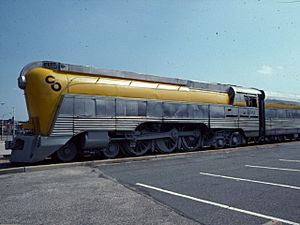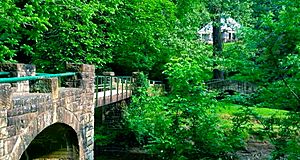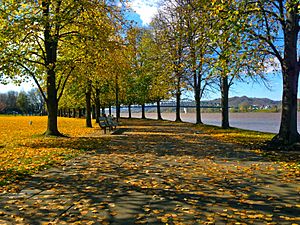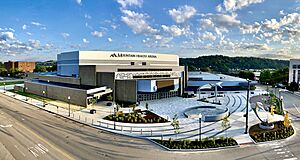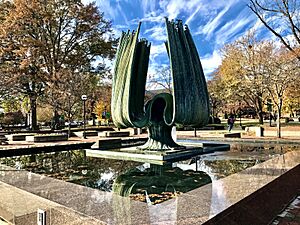Huntington, West Virginia facts for kids
Quick facts for kids
Huntington
|
|||||
|---|---|---|---|---|---|
|
|
|||||
|
|||||
| Nickname(s):
The Jewel City, The River City, The River & Rail City, Train City
|
|||||
| Country | United States | ||||
| State | West Virginia | ||||
| Counties | Cabell, Wayne | ||||
| First Settled | 1775 (Holderby's Landing) | ||||
| Founded | 1871 | ||||
| Incorporated | 1799 (Guyandotte) | ||||
| Incorporated | February 27, 1871 (Huntington) | ||||
| Founded by | Collis P. Huntington, Delos W. Emmons |
||||
| Government | |||||
| • Type | Mayor-Council | ||||
| Area | |||||
| • City | 18.461 sq mi (47.814 km2) | ||||
| • Land | 16.219 sq mi (42.008 km2) | ||||
| • Water | 2.242 sq mi (5.808 km2) | ||||
| Elevation | 564 ft (172 m) | ||||
| Population
(2020)
|
|||||
| • City | 46,842 | ||||
| • Estimate
(2023)
|
45,325 | ||||
| • Rank | US: 886th WV: 2nd |
||||
| • Density | 2,794.6/sq mi (1,079.0/km2) | ||||
| • Urban | 200,157 (US: 191st) | ||||
| • Metro | 368,261 (US: 152nd) | ||||
| • Combined | 643,394 (US: 81st) | ||||
| Demonym(s) | Huntingtonian | ||||
| Time zone | UTC−5 (Eastern (EST)) | ||||
| • Summer (DST) | UTC−4 (EDT) | ||||
| ZIP Codes |
25701–25729, 25755, 25770–25779
|
||||
| Area code(s) | 304 and 681 | ||||
| FIPS code | 54-39460 | ||||
| GNIS feature ID | 1540605 | ||||
| Highways | US-60, I-64, SR-101, SR-106, SR-152, and SR-527 | ||||
| Sales tax | 7.0% | ||||
Huntington is a city in West Virginia, located where the Ohio and Guyandotte rivers meet. It's the county seat for Cabell County and is also partly in Wayne County. In 2020, about 46,842 people lived here, making it the second-largest city in West Virginia. The larger Huntington–Ashland metropolitan area includes parts of West Virginia, Kentucky, and Ohio, with over 368,000 people.
Huntington started as Holderby's Landing in 1775. It became a planned city in 1871, named after Collis Potter Huntington, who founded the Chesapeake and Ohio Railway. This railroad helped Huntington grow into a major center for manufacturing, transport, and other industries like coal and steel. After World War II, many of these industries closed down. This caused the city's population to drop from its highest point of 86,353 in 1950 to 46,842 in 2020.
Today, Huntington is an important place for moving goods from trains to river boats. It's home to the Port of Huntington Tri-State, which is the second-busiest inland port in the United States. The city is also known for Marshall University, the Huntington Museum of Art, and Camden Park, one of the oldest amusement parks in the world.
Contents
- Huntington's History: From Landing to Modern City
- Huntington's Location and Climate
- Cityscape: Exploring Huntington's Look and Feel
- Economy: How Huntington Makes a Living
- Culture: Arts, Entertainment, and Local Traditions
- Parks and Recreation: Enjoying the Outdoors
- Sports: Cheering on the Teams
- Media: News, TV, and Radio
- Education: Schools and Universities
- Transportation: Getting Around Huntington
- Infrastructure: City Services
- Notable people
- See also
Huntington's History: From Landing to Modern City
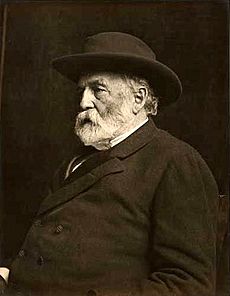
The land where Huntington now stands was first settled in 1775. Before Huntington was officially named, the area was known as Holderby's Landing. An older town called Guyandotte was built nearby in 1799 by French settlers.
The modern city of Huntington was founded in 1871 by Collis P. Huntington and Delos W. Emmons. They chose this spot for the western end of the Chesapeake and Ohio Railway (C&O). Collis P. Huntington was a famous railroad builder who also helped build the first U.S. transcontinental railroad. The C&O railroad was finished in 1873, connecting Richmond, Virginia to the Ohio River Valley. This new railroad helped the small town of Guyandotte grow into the larger city of Huntington. Guyandotte officially became part of Huntington in 1891.
On December 31, 1871, Peter Cline Buffington was elected as Huntington's first mayor. The city quickly set up a police force. In 1872, Huntington faced a smallpox outbreak.
In 1875, the Huntington Bank was robbed. The robbers were caught, but local stories that the famous Jesse James Gang was involved are not true.
Huntington was one of the first cities in America to have electric streetcars, starting in 1888. These streetcars were later replaced by buses. Camden Park, one of the world's oldest amusement parks, was built in 1903 to encourage people to ride the trolleys.
Huntington grew very quickly from its founding until the Ohio River Flood of 1937. This flood caused a lot of damage, left many people homeless, and led to the building of flood walls in 1938. After World War II, the city's population began to decrease as industries like steel and manufacturing declined.
In the late 1980s, Huntington started to change its focus to education, tourism, and healthcare. Even though the city's economy changed, its population has not returned to the high numbers it had during its industrial peak.
Huntington in the 21st Century
Huntington has seen a big comeback since the early 2000s. Key events include the opening of Pullman Square in 2005 and the filming of the movie We Are Marshall in 2006. The Huntington–Ashland metropolitan area is now the largest in West Virginia. Major employers today include Marshall University, Cabell Huntington Hospital, St. Mary's Medical Center, Amazon, and DirecTV.
The city has also improved its downtown areas, like Fourth Avenue and Ninth Street, making them more friendly for walking and biking. Old buildings, like the Anderson-Newcomb/Stone & Thomas Building, have been turned into new spaces for Marshall University's art programs.
Huntington's Location and Climate
Huntington is in the southwestern part of West Virginia, right on the border with Ohio. It sits on the southern bank of the Ohio River, where the Guyandotte River flows into it. Most of the city is in Cabell County, which is its county seat. A smaller part of the city, like the Westmoreland neighborhood, is in Wayne County.
The city is influenced by different cultures, including Appalachian, Southern, Midwestern, and Mid-Atlantic. People sometimes call it one of the northernmost cities in the South or one of the southernmost cities in the North.
The Huntington–Ashland metropolitan area is sometimes called KYOWVA, which stands for Kentucky, Ohio, and West Virginia. This area is the largest in West Virginia.
Huntington has a total area of about 18.46 square miles (47.81 square kilometers). Most of this is land, with some water from the rivers.
Huntington's Weather Patterns
Huntington has four distinct seasons. Summers are warm and humid, but not as hot as areas further south. Winters bring moderate snowfall, with about 23 inches (58 cm) each year. On average, the temperature reaches 90°F (32°C) about 24 days a year, and stays below freezing for 16-17 days. The highest temperature ever recorded was 108°F (42°C) in July 1930, and the lowest was -24°F (-31°C) in February 1899.
Cityscape: Exploring Huntington's Look and Feel
Huntington's main business area is between the Ohio River and the CSX Railroad tracks. There are also two smaller business areas: "Old Central City," known for its antique shops, and one in Guyandotte. The city has many different building styles, including Gothic, Art Deco, and Tudor Revival homes.
After Pullman Square was built, the city improved streets like 9th Street and Fourth Avenue. 9th Street, which used to be a closed plaza, is now open to cars again and attracting new businesses. Fourth Avenue, connecting downtown to Marshall University, was also updated with new lights, art, and bike lanes.
Marshall University bought the old Anderson-Newcomb/Stone & Thomas Building, built in 1902, to turn it into a modern visual arts center. This helps the college grow and gives art students more chances to get involved in the community.
Huntington has always been a key spot for moving goods between trains and the Ohio River/Mississippi River system. The Huntington Division of CSX Transportation is still the largest part of its network. A lot of its business comes from moving coal from West Virginia and Kentucky to the Port of Huntington-Tristate. From there, the coal is loaded onto river barges and sent to other states.
Huntington's Neighborhoods
Huntington is generally divided into four main parts. The CSX railroad tracks divide the city north and south, and First Street divides it east and west. Within these sections, there are many neighborhoods, including:
- Downtown: Downtown Huntington, Marshall University Campus
- West: West Huntington, Old Central City, Westmoreland
- South: Anita Heights, Beverly Hills/South Hills, Enslow Park, Fairfield, Gaylersville, Harveytown, Marcum Terrace, Reid, South Side, Southeast Hills, Ritter Park
- East: Walnut Hills, Forest Hills, Altizer, Guyandotte, Highlawn, Arlington Park, Stamford Park
Historic Districts: A Look Back in Time
Huntington has several historic districts, which are areas with many old buildings that have special historical or architectural importance.
Downtown Historic District
This district includes many of the old commercial buildings in downtown Huntington. It's a great place to see different architectural styles.
Some important buildings here include:
- Anderson-Newcomb/Stone & Thomas Building (built around 1902)
- Keith-Albee Theatre (1928)
- Huntington City Hall (1915)
- West Virginia Building (around 1924), which is Huntington's tallest building.
The old Davis Opera House/Huntington Theatre has recently been updated into a lively space with shops and restaurants.
Ritter Park Historic District
This district is in the South Side and includes the beautiful Ritter Park. Many homes in this area were built between 1913 and 1940 and show styles like Colonial Revival and Tudor Revival.
Other Historic Districts
- 14th Street West Historic District
- Hawthorne Historic District
- Mortimer Place Historic District
- Ninth Street West Historic District
Economy: How Huntington Makes a Living
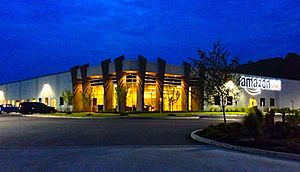
Huntington's economy used to be based on making steel, shipping, and transportation. When these industries declined, the city lost many jobs. Now, Huntington has changed its focus to new areas like technology, healthcare, and tourism.
The biggest employers in Huntington today are Marshall University, Cabell Huntington Hospital, St. Mary's Medical Center, Amazon, and DirecTV.
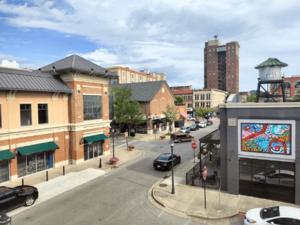
For shopping, the Huntington Mall is the largest mall in West Virginia. Downtown Huntington also has many unique shops and restaurants, especially around Pullman Square.
A new area of growth is Kinetic Park, a technology park near Interstate 64. Amazon opened a large Customer Service Center there in 2011, and other businesses have followed.
Huntington has a long history with manufacturing. The Ensign Car Works, founded in 1872, made parts for railroad cars. Later, the ACF plant in Huntington built many innovative freight cars. While these large plants have changed or closed, the city is still strong in metalworking and welding.
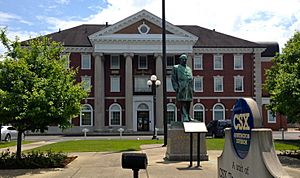
Huntington remains a key point for moving goods by rail and river. The CSX Transportation network's Huntington Division is very important for moving coal from West Virginia and Kentucky. This coal often goes to the Port of Huntington-Tristate to be loaded onto river barges.
Huntington is also home to Heiner's Bakery, which started in 1905 and still makes bread and other baked goods today.
Culture: Arts, Entertainment, and Local Traditions
Huntington's culture is a mix of Appalachian, Southern, Midwestern, and Mid-Atlantic influences. The city has been featured in movies like We Are Marshall and TV shows like Jamie Oliver's Food Revolution.
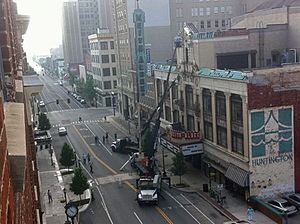
One of Huntington's most famous places is the Keith-Albee Theatre. This beautiful "Art Deco" theater was built in 1928 for vaudeville shows. It was once the second-largest theater in the United States. Today, it's called the Keith Albee Performing Arts Center and has been undergoing restoration since 2009. Its famous sign, which had been taken down, was put back up in 2012 after a community effort to save it.
Cam's Ham is a local restaurant famous for its "Original Sugar-Flaked Ham" sandwich. It was even named the best sandwich in West Virginia by the Food Network.
Museums: Learning and Exploring
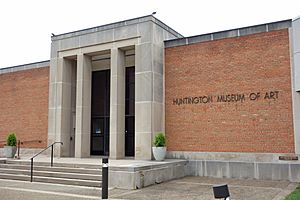
Huntington has several museums for you to explore:
- The Huntington Museum of Art, located in the hills above Ritter Park, has many art collections and a conservatory.
- The Huntington Children's Museum near Old Central City offers interactive exhibits for kids.
- Safety Town is a miniature town that teaches children about road and transportation safety.
- The Touma Museum of Medicine displays over 2,800 medical items.
- Heritage Farm Museum and Village is an outdoor village with museums about Appalachian history.
- The Museum of Radio and Technology shows the history of radio and technology.
- The Huntington Railroad Museum focuses on the city's rich railroad history.
Annual Events and Fairs: Fun for Everyone
Huntington hosts many exciting events throughout the year:
- Appalachian Film Festival: Showcases films about Appalachian culture.
- Guyandotte Civil War Days: Features arts, crafts, food, and entertainment.
- Huntington Music & Arts Festival: Celebrates local and regional music and visual artists in Ritter Park.
- Rails and Ales Festival: West Virginia's largest beer festival.
- West Virginia Hot Dog Festival: Celebrates unique hot dog styles.
- Tsubasacon: An anime convention with guests, games, and special events.
Camden Park: A Historic Amusement Park

Camden Park is a 26-acre amusement park near Huntington. It has over 30 rides and attractions, including two historic wooden roller coasters: the Big Dipper (built in 1958) and the Lil' Dipper (built in 1961). The park also hosts various events like the Children's Festival and Halloween Spooktacular.
Camden Park was built in 1903 to encourage people to ride the trolley line. It is West Virginia's only amusement park and is still owned and operated by the Boylin Family.
Parks and Recreation: Enjoying the Outdoors
Huntington has eleven public parks managed by the Greater Huntington Park and Recreation District. The most popular are Harris Riverfront Park and Ritter Park. Camden Park, the amusement park, is also nearby.
Ritter Park: A Green Oasis
Ritter Park is the most famous park in Huntington. It was named after Charles L. Ritter, who donated the land, and was created in 1913. The park has long walking and cycling trails along Four Pole Creek, with many wooden and stone bridges. You'll also find picnic areas, a playground, an amphitheater, a beautiful rose garden, and a dog park.
The Rose Garden is a popular spot for weddings and special events. It has over 3,500 rose plants and is designed with stone walls and benches.
Other Parks to Explore
- Harris Riverfront Park is downtown on the Ohio River. It hosts concerts and outdoor movie nights.
- Memorial Park has a walking trail, playground, and the historic Memorial Arch. This arch was built between 1924 and 1929 to honor those who served in World War I. It's the only arch of its kind in West Virginia.
- McClelland Park, near St. Mary's Hospital, has tennis courts, a basketball court, and a playground.
- Harveytown Park is a newer park with picnic tables and a grill.
- Camp Mad Anthony Wayne offers open grounds, hiking trails, a disc golf course, and a lodge.
Beech Fork State Park: Nature Nearby
Beech Fork State Park is about 15 miles (24 km) south of downtown Huntington. It's located on the shores of Beech Fork Lake, which was built in the 1970s to help control floods.
Sports: Cheering on the Teams
Professional Sports
Huntington has a history of professional sports teams, including:
- Indoor football teams like the River Cities LocoMotives and the Huntington Hammer.
- Baseball clubs like the Huntington Blue Sox and the Huntington Cubs. A new summer league baseball team, the Tri-State Coal Cats, will start playing in 2024.
College Sports: Marshall Thundering Herd
Marshall University's sports teams are called the Marshall Thundering Herd. Their colors are kelly green and white. They play in FBS for football as part of the Sun Belt Conference. The name "Thundering Herd" comes from a 1925 novel.
Marshall has teams for many sports, including football, baseball, basketball, soccer, softball, and more. Their football team plays at Joan C. Edwards Stadium, and basketball is played at the Cam Henderson Center.
On November 14, 1970, a plane carrying 75 Marshall University football players, coaches, and staff crashed near the Tri-State Airport. This was a very sad event, known as "the worst sports-related air tragedy in U.S. history."
Other Sports
Huntington has also been home to ice hockey teams like the Huntington Stars and the Huntington Blizzard. Marshall University also has a club ice hockey team.
The city is home to the Jewel City Roller Girls, a women's roller derby team.
Media: News, TV, and Radio
Print Media
Huntington has a daily newspaper called The Herald-Dispatch, which is one of the largest in West Virginia. Marshall University also has its own student newspaper, The Parthenon.
Television
Huntington and Charleston share a single TV market. Here are some of the TV stations you can watch:
| Call sign | Channel | Affiliations |
|---|---|---|
| WSAZ-TV | 3 | NBC / MyNetworkTV on DT2 |
| WCHS-TV | 8 | ABC / Fox on DT2 |
| WVAH | 11 | Catchy Comedy |
| WOWK | 13 | CBS |
| WLPX | 29 | ION |
| WQCW | 30 | The CW |
| WVPB | 33 | PBS |
| WTSF | 61 | Daystar |
Radio
Huntington has many radio stations playing different types of music and talk shows:
| Call sign | Frequency | Format | Description / Notes |
|---|---|---|---|
| WMUL | 88.1 FM | College radio | Operated by Marshall University. |
| WVPB | 89.9 FM | NPR | West Virginia Public Radio |
| WCMI-FM | 92.7 FM | Active rock | "The Planet" |
| WDGG | 93.7 FM | Country | |
| WBVB | 97.1 FM | Greatest Hits | "The Tri-State's Greatest Hits" |
| WMGA | 97.9 FM | Hot AC | |
| WKEE | 100.5 FM | Top 40 | "100.5 KEE-FM" |
| WXBW | 101.5 FM | Classic country | "Big Buck Country 101.5" |
| WTCR-FM | 103.3 FM | Country | |
| WKLC | 105.1 FM | Rock | Rock 105 "Everything That Rocks." |
| WAMX-FM | 106.3 FM | Rock | 1063 The Brew "Huntington's Only Classic Rock Station." |
| WEMM-FM | 107.9 FM | Southern gospel | "Gospel 107.9" |
| WVHU | 800 AM | News/Talk | News Talk 800 & 1600 (simulcast) |
| WRVC (AM) | 930 AM/94.1 FM | ESPN Talk | |
| WNRJ | 1200 AM | Southern gospel | Southern gospel and patriotic music |
Education: Schools and Universities
Schools for All Ages
Students in Huntington attend schools in the Cabell and Wayne County School Systems. This includes high schools like Huntington High School, Cabell Midland High School, and Spring Valley High School. There are also middle schools and elementary schools. For private education, options include St. Joseph Catholic School and Grace Christian School.
Higher Education: Marshall University and More
Marshall University is a public research university in Huntington. It was founded in 1837 and is named after John Marshall, a famous Chief Justice of the United States. Marshall University has many colleges and schools for both undergraduate and graduate students.
Other places for higher education in Huntington include:
- The Robert C. Byrd Institute for Advanced Manufacturing
- Mountwest Community & Technical College
- Huntington Junior College
- St. Mary's Medical Center's Schools of Medical Imaging, Nursing, and Respiratory Care
- The Tri-State Institute of Pharmaceutical Sciences
Transportation: Getting Around Huntington
Roads and Highways
Huntington has a grid-like street pattern with wide avenues running east and west, and numbered streets running north and south. Key roads include:
- Interstate 64 (I-64)
- U.S. Route 60 (US 60)
- US 52 (West Huntington Expressway)
- West Virginia Route 2 (WV 2)
- WV 10
- WV 101
- WV 106
- WV 152
- WV 527
Bridges: Connecting Across the Ohio River
Huntington has bridges that cross the Ohio River to Ohio:
- The Robert C. Byrd Bridge connects Huntington to Chesapeake, Ohio. It was completed in 1994. The previous bridge, the 6th Street Bridge, opened in 1926.
- The East Huntington Bridge (also called the "Frank Gatski Memorial Bridge") is a cable-stayed bridge that crosses the Ohio River to Proctorville, Ohio. It was finished in 1985.
Rail Travel
Huntington has always been important for train travel. The CSX Transportation network's Huntington Division is still the largest part of its system. Trains bring a lot of coal from West Virginia and Kentucky to the Port of Huntington-Tristate, where it's loaded onto river barges.
The city also has an Amtrak station, which is part of the Cardinal line that runs between New York City and Chicago three days a week.
Public Transportation
TTA provides bus service throughout Huntington and the surrounding areas in West Virginia and Ohio. You can take buses from Huntington to places like Milton, West Virginia and Proctorville, Ohio. The main bus station is the TTA Center in downtown Huntington.
River Transportation
The Port of Huntington-Tristate is the largest inland port in the United States based on the amount of goods moved. This is largely because of the coal and petroleum products that are loaded onto barges here.
Air Travel
The public Tri-State Airport, located southwest of the city, offers commercial flights from Allegiant Air and American Eagle. Huntington also has a private airport, Robert Newlon Field.
Infrastructure: City Services
Emergency Services
The Huntington Police Department is the main law enforcement agency in the city, with about 100 officers. The Marshall University Police Department provides security for the university campus. The West Virginia State Police also have a presence in Huntington.
The Huntington Fire Department, founded in 1897, protects the city with about 100 professional firefighters. They have six fire stations with various trucks and equipment.
Healthcare Services
Huntington has two large hospitals: St. Mary's Medical Center and Cabell Huntington Hospital. Both are part of Mountain Health Network and are the only designated trauma centers in the region.
- St. Mary's Medical Center is the largest medical facility in Huntington with 393 beds. It's also a teaching hospital for Marshall University's medical school and offers training programs for nurses and other medical professionals.
- Cabell Huntington Hospital is a 303-bed hospital that serves patients from West Virginia, Kentucky, and Ohio. It's also a teaching hospital for Marshall University's medical and nursing schools.
The Huntington Veteran's Administration (VA) Medical Center provides care for veterans. It's also a teaching facility for the Marshall University School of Medicine.
Notable people
See also
 In Spanish: Huntington (Virginia Occidental) para niños
In Spanish: Huntington (Virginia Occidental) para niños


